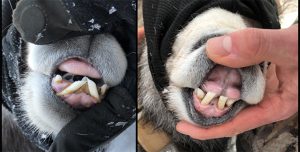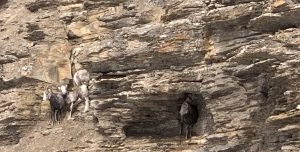Health and behaviour of BC’s southern-most Stone’s Sheep
This multi-year project, led by the Wild Sheep Society of BC, will focus on the two southern-most, functionally viable Stone’s Sheep populations, the Dunlevy and Schooler herds. Due to their proximity to domestic farms and overlap with elk, these wild sheep are at high risk. The project will reassess their health and examine population demographics, behaviour, distribution, and habitat use of Stone’s Sheep through use of GPS collars. Information gained from this project could be used to inform future conservation and enhancement actions for Stone’s Sheep.
Update: Data gathering and monitoring of Stone’s sheep continues
Ten wild sheep have been outfitted with GPS collars as part of a multiyear project to examine the population demographics, behaviour, distribution, and habitat use of the two southernmost functionally viable herds of Stone’s sheep. With these newly deployed collars, the project’s sample size is up to 16 sheep in the Dunlevy and Schooler herds, which are at high risk of exposure to pathogens because of their proximity to domestic farms and elk.
The project, led by the Wild Sheep Society of British Columbia with funding from the FWCP, also gathers data through observation and health assessments. Fifty sheep, including six lambs, were observed in a late March 2021 survey of the Dunlevy herd, which points to a relatively stable population. Eight sheep in the herd were tested for five viral and bacterial pathogens known to affect wild sheep, and all had negative results. Fecal glucocorticoid metabolite levels, however, indicate these sheep are at a significantly higher stress level than those in other herds.
Stone’s sheep is an inventory species in our Peace Region’s Uplands Action Plan, meaning inventory and/or trend monitoring is required to better understand population status, critical habitat needs, and key limiting factors. The next steps for this project will be to study the collared sheep to determine movement, behaviour, and landscape use.
Photos: Landon Birch
Executive Summary
In year two our goals were: 1) To safely capture and collar up to 14 Stone’s sheep in the Dunlevy and Schooler herds; 2) To perform a herd health assessment to support the thinhorn sheep herd health assessment team and compare to baseline metrics from 15 years ago; 3) To evaluate hair loss and tick abundance; and 4) To examine population demographics, behavior and distribution. A total of 10 sheep were safely captured, sampled and collared in March 2021, for a total of 16 active collars at the time of report submissions. Seven sheep, all ewes, were captured using drive-netting methods on 20 Mile Point in the Dunlevy herd area, the first known use of this method in nearly 17 years. Five of these ewes exhibited mild-moderate hair loss. Three sheep, two rams and one ewe were captured in the Schooler range, the first successful deployment of collars in this area. All three exhibited no significant hair loss. All previously collared ewes and rams survived the entire year, and lamb recruitment was also 1.00 for both collared ewes in year one, though our sample size was small (n=5 collared ewes). The lamb ewe ratio dropped from 39:100 in late June to 20:100 in March, for an overall observed recruitment of six lambs into the Dunlevy herd. To date one sheep has died from capture-related activities in March 2020. Seasonal movements varied by area and movement strategy. Three ewes were identified as migratory, and the remaining two ewes and single ram were all identified as high elevation residents. Health results from year one capture activities came back negative for five viral and bacterial pathogens commonly carried by domestic ruminants and known to affect wild sheep: 1) Bovine viral respiratory virus, 2) Ovine progressive pneumonia, 3) Parainfluenza virus, 4) Infectious bovine rhinotracheitis, and 5) Mycoplasma ovipneumoniae (MOVI).
Click the provincial database link below to read the full final report for this project.




